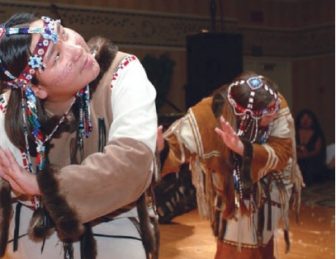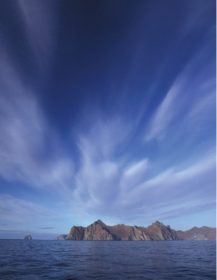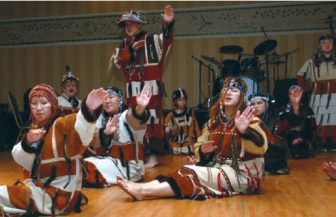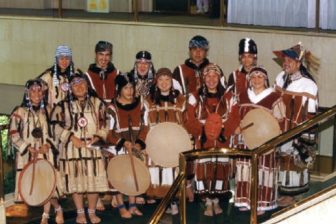 The Aleuts inhabit the Aleutian Archipelagos that span from the Alaska Peninsula to the Commander Islands in Russia. Their original name is Unangan and Unangus, meaning “the people.” Their aboriginal lifestyle was based on survival and developed in response to their environment in this land they called “the birthplace of the winds” and “the cradle of storms.” They fashioned unique tools from the materials available on their barren islands and learned to utilize every valuable part of their prey or what they gathered. Claiming their hunting grounds in both the North Pacific and Bering Seas, they became expert hunters in boats fashioned from driftwood and skin. The first was their primary hunting vessel, the iqax, which became known as the kayak (the Russians called it a baidarka). The second was a vessel crafted large enough to transport their families in. The weather on these treeless, volcanic islands is nearly uniform in temperature, with high winds the Aleuts say can be “like a river.” Their skill in reading the currents and navigating in the constant fog was key to their survival. Did the ancestors of the Aleuts cross the Bering land bridge and/or arrive via watercraft, hunting mammals along the edges of Beringia? Are they more closely related to the Eskimos or the Natives in the southeastern part of Alaska, the Tlingit and Haida? How have the changes since post-European contact affected the people known as the Aleuts?
The Aleuts inhabit the Aleutian Archipelagos that span from the Alaska Peninsula to the Commander Islands in Russia. Their original name is Unangan and Unangus, meaning “the people.” Their aboriginal lifestyle was based on survival and developed in response to their environment in this land they called “the birthplace of the winds” and “the cradle of storms.” They fashioned unique tools from the materials available on their barren islands and learned to utilize every valuable part of their prey or what they gathered. Claiming their hunting grounds in both the North Pacific and Bering Seas, they became expert hunters in boats fashioned from driftwood and skin. The first was their primary hunting vessel, the iqax, which became known as the kayak (the Russians called it a baidarka). The second was a vessel crafted large enough to transport their families in. The weather on these treeless, volcanic islands is nearly uniform in temperature, with high winds the Aleuts say can be “like a river.” Their skill in reading the currents and navigating in the constant fog was key to their survival. Did the ancestors of the Aleuts cross the Bering land bridge and/or arrive via watercraft, hunting mammals along the edges of Beringia? Are they more closely related to the Eskimos or the Natives in the southeastern part of Alaska, the Tlingit and Haida? How have the changes since post-European contact affected the people known as the Aleuts?
The New World
During the last glacial maximum (formed between Asia and America), known as Beringia, also the Bering land bridge, it was first speculated that the ancestors of the Aleuts made their way by walking into the New World to settle in the circumpolar zone of the Aleutian Islands. Stronger support is forming for maritime entrance into the New World as more evidence surfaces, like the discovery of fossils of bears carbon-dated to more than 12,000 years ago and of a young man dating back more than 9,000 years ago, on Prince of Wales Island in southeast Alaska, which was thought to be glacially covered. Dr. Tim Heaton is doing the study of these fossils and the possibility of glacier-free areas, existing along what now are islands that border Alaska. This opens the possibility that Aleuts, as well as other Native Americans (either during or after other glaciating processes) could travel via waterway to the Americas.
Due to the location of the Aleuts and the various traits they exhibit, questions have developed as to what Native group the Aleuts originated from, either the Eskimos or the Tlingit. William S. Laughlin presented that the Aleuts came from the “proto- Eskimo-Aleut culture.” Linguists like Swadesh, Hirsch, and Bergsland suggest that the Aleuts separated from a proto-Eskimo-Aleut Language around 4,000 years ago. Mitochondria DNA research by Dennis O’Rourke and Geoff Hayes reveals that the Aleuts became their own people about 6,000 years ago.
Did the Aleuts come by land or sea? Was the split prior to or after the linguistic Eskimo language? Within these equations is an Aleut myth, mentioned in Baidarka as a Living Vessel: On the Mysteries of the Aleut Kayak Builders (1988), which backs a theory that the Aleuts migrated from the east (the mainland, after arriving either easterly by land or westerly by water). In this account, the Aleuts moved after their “creation,” from the overpopulated Chilkak (translation perhaps “Chilkat,” a Haines, Alaska, area) so they could have their own land.
Lifestyle, Kayaks, and Feasts
The winter home construction was semi-subterranean, allowing several families to coexist, as each family had their section of the building. Being a paternal nonequalitarian society, the people lived in accordance
with their status in a hierarchy, with a chief at the top and slaves at the bottom. During the nomadic summer hunting seasons, a hole would be dug (at their choice of camp) for sleeping, and woven mats of grass would be used to cover the ground or for blankets.
Their parkas would be laid on top of the mats for warmth and insulation. Parkas were made from the fur of walrus, seals, caribou, bear, and bird skins. Waterproof overshirts were made from sewn strips of walrus intestines. There was no campfire; to gain heat, a small smoldering fire was made from grasses, and then the person would stand over it, and then lower his or her parka.
Their main vessel, the kayak, was unique in design:
- It had a cleft bow to cut through the waves.
- It was stated to be so light, even “a child” could carry it.
- The original design was made with bone and stone joints for flexibility.
- This complex design was made from memory.
- It was clocked at 7 to 10 miles an hour.
Each season, the chief occupation within the settlement was survival, and all activities were geared to the preparation and productions of food, in hopes of accumulating an abundance to celebrate the numerous “pot- latches” throughout the feasting fall and winter season. The months were named in accordance with the activities through the year, beginning in March, which was “a time of eating skin.”Around this month, the food supply was spent, and the weather was so bad, the only option left was to forage for mollusks and perished sea mammals washed ashore, and when none could be found, then the skin obtained from the previous season became their meal.
 Spring brought migrating birds, which were caught within whalebone nooses. Pinnipeds of large numbers made brief stops to the island chain en route to their nesting rookeries on the fringes of the Bering Sea. From spring to autumn, the rivers spawned three varieties of salmon. Also, from early spring to late autumn, migrating fur seals from as far as California were hunted with darts. Late spring to early summer, the sea otters arrived (the most coveted fur for clothing). Summer brought whales, walrus, berries, and edible roots, as well as grasses for basket weaving.
Spring brought migrating birds, which were caught within whalebone nooses. Pinnipeds of large numbers made brief stops to the island chain en route to their nesting rookeries on the fringes of the Bering Sea. From spring to autumn, the rivers spawned three varieties of salmon. Also, from early spring to late autumn, migrating fur seals from as far as California were hunted with darts. Late spring to early summer, the sea otters arrived (the most coveted fur for clothing). Summer brought whales, walrus, berries, and edible roots, as well as grasses for basket weaving.
Winter was the season of celebration, a time of feasting, dancing, and masks. Aleut potlatches resembled those of the northwest coast Natives. The winter festivals included the distribution of gifts and performances of accessional reenactments in songs and dances. Many of the same themes and activities of northwest potlatches existed, such as the funeral potlatch, the killing or freeing of slaves during this time, games, and Raven (a common thread to the North Pacific Rim “First People,” from Russia down to Washington); he is also a hero in their myths, and they likewise considered him their ancestor.
Enter the Europeans
During the second Kamchatka Expedition (1733-1743), Vitus Bering (commanding the St. Peter) and Aleksey Chirikov (the St. Paul), encountered island dwellers, who at that time were called the Unangan (the eastern dialect) and the Unangus (the western dialect), which means “the People,” at Unga and Nagni Islands. It was after this trip that these people became known as the “Aleuts,” though the origin of this name is unknown. The discovery of the wealth of fur available at the Aleutian Islands started a “fur rush” to Alaska. The Russians claimed a sovereignty over the land they called “Alyeshka,” from 1741 to 1867. Skirmishes developed when the Russians began enforcing a dominant role in the Aleuts’ lives, as well as killing entire villages. The world of these Arctic peoples, their culture and sustenance for thousands of years, disappeared in large part due to their adoption of the Russian Orthodox religion; their dependence on Europeans for clothes, food, other merchandise, and wage earning; and general assimilation to European culture. Parts of the Aleut culture were totally lost, as Shirley A. Hauck found in her study about how the aboriginal Aleut music became extinct due to European contact.
 When the “sale” of Alaska was transacted, this also brought many changes to the Aleut community. For example, the original homes were semi-subterranean, but the Americans transported lumber to build houses on the island, and they were very drafty in comparison and brought sickness to elders and young children. A new language was enforced when a law passed in 1866 concerning public schools that only English could be spoken. Also, the Aleuts, especially those of the Pribilof Islands, were the only Alaskan Natives to become subjects of America in the service of fur companies. The Americans also indiscriminately overhunted the fur seals, so that by 1913, their extinction was feared and the United States declared a 5-year sealing holiday.
When the “sale” of Alaska was transacted, this also brought many changes to the Aleut community. For example, the original homes were semi-subterranean, but the Americans transported lumber to build houses on the island, and they were very drafty in comparison and brought sickness to elders and young children. A new language was enforced when a law passed in 1866 concerning public schools that only English could be spoken. Also, the Aleuts, especially those of the Pribilof Islands, were the only Alaskan Natives to become subjects of America in the service of fur companies. The Americans also indiscriminately overhunted the fur seals, so that by 1913, their extinction was feared and the United States declared a 5-year sealing holiday.
World War II
On June 7, 1942, a Japanese invasion came to the Island of Attu, resulting in 42 villagers, both Aleut and Caucasian, being taken as prisoners of war and relocated to Otaru, an island in Japan, for 3 years. The American government responded by ordering the evacuation of the Aleutian and Pribilof Islands, sending 881 Aleuts from nine villages to camps called “duration villages” in southeast Alaska for 2 years. The Aleuts left their islands with suitcases and blanket rolls and the memory of their villages burning. In 1944, the Aleuts were allowed to return to their homeland, but four of the villages were never to be inhabited again.
Aleuts Today
 The Aleuts appear to have survived by becoming skilled in their ever-expanding environment. They are true children from “the cradle of the storms,” having survived wind and cold, volcanoes and earthquakes, oppression by fur traders, World War II invasion and relocation, as well as other challenges as they evolved into modern life. Today, the Aleut language is being taught in schools, as well as the culture. A young 13-year-old Aleut, John Bell (Bennie) Benson, made his mark in history with the design of the Big Dipper for the Alaska State flag, in a contest prior to Alaska’s statehood. An Aleut artist, Thomas Stream, from Kodiak, has become an abstract artist, blending Aleut subjects into his gouache paintings and playing a part in evolving Aleut art with colorful and playful themes. The Aleutian Chain has become a home to the tourist and fishing industry. With airports, computers, and other expanding luxuries, the present-day Aleuts have emerged as a modern people, reclaiming and honoring their ancestral culture and redefining what it means to be an Aleut, to be an Unangan.
The Aleuts appear to have survived by becoming skilled in their ever-expanding environment. They are true children from “the cradle of the storms,” having survived wind and cold, volcanoes and earthquakes, oppression by fur traders, World War II invasion and relocation, as well as other challenges as they evolved into modern life. Today, the Aleut language is being taught in schools, as well as the culture. A young 13-year-old Aleut, John Bell (Bennie) Benson, made his mark in history with the design of the Big Dipper for the Alaska State flag, in a contest prior to Alaska’s statehood. An Aleut artist, Thomas Stream, from Kodiak, has become an abstract artist, blending Aleut subjects into his gouache paintings and playing a part in evolving Aleut art with colorful and playful themes. The Aleutian Chain has become a home to the tourist and fishing industry. With airports, computers, and other expanding luxuries, the present-day Aleuts have emerged as a modern people, reclaiming and honoring their ancestral culture and redefining what it means to be an Aleut, to be an Unangan.
References:
- Hauck, S. A. (1986). Extinction and reconstruction of Aleut music and dance. Doctoral dissertation, University of Pittsburg. Ann Arbor, MI: University Microfilms International.
- Jochelson, W. (1966). History, ethnology, and anthropology of the Aleut. Oosterhout, The Netherlands: Anthropological Publications.
- Kohlhoff, D. (1995). When the wind was a river. Seattle, WA: University of Washington Press in an association with Aleutian/Pribilof Islands Association, Anchorage, AK.
- Liapunova, R. G. (1996). Essays on the ethnography of the Aleuts: At the end of the eighteenth and the first half of the nineteenth century (J. Shelest, Trans., W. B. Workman & L. T. Black, ed. assist.). Fairbanks: University of Alaska Press.
- Lubischer, J. (1988). Baidarka as a living vessel: On the mysteries of the Aleut kayak builders. Port Moody, Canada: Baidarka Society.
- Rubicz, R., Schurr, T. G., Babb, P. L., & Crawford,
- H. (2003). Mitochondrial DNA variation and the origins of the Aleuts. Human Biology, 75, 809-835.
Like? Share it!
